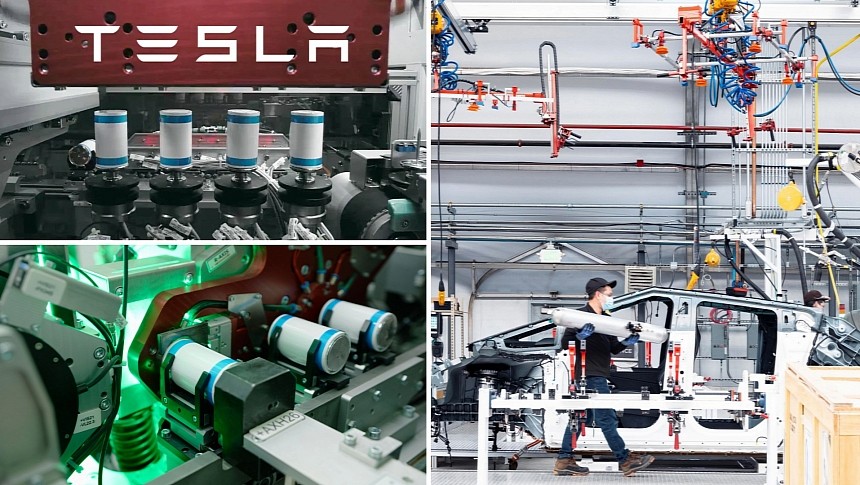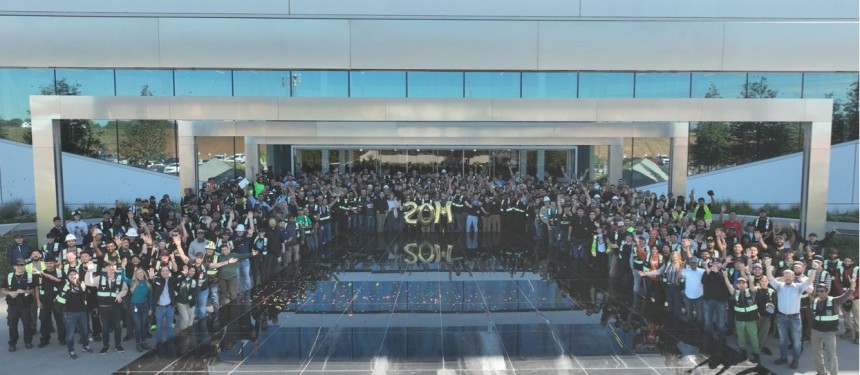Tesla announced a significant milestone for the 4680 cell production at Giga Texas as it built the 20 millionth battery cell at the factory. Rough calculations indicate that Tesla reached a 5-GWh yearly production capacity, which should be enough to ramp up Cybertruck production to at least 25,000 units per year.
When Tesla announced the 4680 cells in 2020 Battery Day, it presented it as a breakthrough in Li-ion battery manufacturing. The 4680 cells were touted as more than just a larger form factor. Tesla also promised chemistry and manufacturing improvements that were set to change the Li-ion batteries forever.
Three years later, the 4680 cells are still in a (mostly) experimental form. Tesla hasn't succeeded in advancing the silicon anode technology it promised or the dry battery electrode manufacturing process. Although it started production of 4680 cells both at Fremont and Giga Texas, the run rate was small, barely enough to build the base-version Model Y.
This isn't to say that Tesla did not make any progress with 4680 cell production. As announced earlier, it gradually ramped up production at Giga Texas, where it makes the second generation of 4680 cells. We still don't know whether these cells have anything special besides a 10% improvement in energy density, but they are crucial for the production of the Cybertruck. They didn't call them "Cybercells" for nothing.
The imminent arrival of the Cybertruck changed the economics significantly, as the electric pickup would require a large amount of 4680 cells for its structural battery pack. Thankfully, Tesla expanded production and announced their 20 millionth 4680 cell produced at Giga Texas. While this milestone is significant, it doesn't tell the whole story. Tesla announced its first million 4680 cells produced at its Kato Road facility in January 2022, and the 10-million milestone was reached in June 2023, after 17 months.
Now things get crazy, as it took Tesla only four months to produce another 10 million cells. This indicates a massive 4680-cell production ramp at Giga Texas, which is on track to become Tesla's primary battery production facility. This exponential growth suggests that Tesla's 4680-cell production capacity will further expand by the year's end and is not even close to peaking.
The production capacity planned at Giga Texas is about 20-25 GWh per production line, according to Jordan Giesige from the Limiting Factor channel (@LimitingThe), which tracks the Li-ion battery industry. The goal is to eventually expand the annual production capacity to 100 GWh, turning Gigafactory Texas into Tesla's main battery manufacturing facility. Giga Nevada, which Tesla operates in partnership with Panasonic, has a production capacity of 50 GWh per year.
According to Jordan's calculations, Giga Texas reached a run rate of more than 5 GWh per year. This estimate is based on a 95 Wh per cell capacity and a 4.5-million-cell monthly production. Depending on the Cybertruck's pack size, this is enough 4680-cell production capacity for at least 25,000 Cybertrucks per year. Considering the slow ramp-up planned for the Cybertruck, this is more than enough for the first year of production. If anything, it appears that Tesla now has excess production capacity for 4680 cells, so it could start putting 4680 cells into more vehicles.
In September, Tesla discontinued the Model Y AWD, the only model it built with 4680 cells. Given the increased cell production and current Cybertruck needs, I wouldn't rule out the Model Y AWD with 4680 cells making a comeback next year. Tesla could also use the cells in the revamped Model 3 built in the US. However, this is a long shot, considering that Fremont has been the last factory to introduce changes into production, with Giga Shanghai and Giga Berlin leading the way.
Three years later, the 4680 cells are still in a (mostly) experimental form. Tesla hasn't succeeded in advancing the silicon anode technology it promised or the dry battery electrode manufacturing process. Although it started production of 4680 cells both at Fremont and Giga Texas, the run rate was small, barely enough to build the base-version Model Y.
This isn't to say that Tesla did not make any progress with 4680 cell production. As announced earlier, it gradually ramped up production at Giga Texas, where it makes the second generation of 4680 cells. We still don't know whether these cells have anything special besides a 10% improvement in energy density, but they are crucial for the production of the Cybertruck. They didn't call them "Cybercells" for nothing.
The imminent arrival of the Cybertruck changed the economics significantly, as the electric pickup would require a large amount of 4680 cells for its structural battery pack. Thankfully, Tesla expanded production and announced their 20 millionth 4680 cell produced at Giga Texas. While this milestone is significant, it doesn't tell the whole story. Tesla announced its first million 4680 cells produced at its Kato Road facility in January 2022, and the 10-million milestone was reached in June 2023, after 17 months.
The production capacity planned at Giga Texas is about 20-25 GWh per production line, according to Jordan Giesige from the Limiting Factor channel (@LimitingThe), which tracks the Li-ion battery industry. The goal is to eventually expand the annual production capacity to 100 GWh, turning Gigafactory Texas into Tesla's main battery manufacturing facility. Giga Nevada, which Tesla operates in partnership with Panasonic, has a production capacity of 50 GWh per year.
According to Jordan's calculations, Giga Texas reached a run rate of more than 5 GWh per year. This estimate is based on a 95 Wh per cell capacity and a 4.5-million-cell monthly production. Depending on the Cybertruck's pack size, this is enough 4680-cell production capacity for at least 25,000 Cybertrucks per year. Considering the slow ramp-up planned for the Cybertruck, this is more than enough for the first year of production. If anything, it appears that Tesla now has excess production capacity for 4680 cells, so it could start putting 4680 cells into more vehicles.
In September, Tesla discontinued the Model Y AWD, the only model it built with 4680 cells. Given the increased cell production and current Cybertruck needs, I wouldn't rule out the Model Y AWD with 4680 cells making a comeback next year. Tesla could also use the cells in the revamped Model 3 built in the US. However, this is a long shot, considering that Fremont has been the last factory to introduce changes into production, with Giga Shanghai and Giga Berlin leading the way.
Tesla just built their 20 millionth 4680 cell at Giga Texas!
— The Limiting Factor (@LimitingThe) October 11, 2023
What does that mean?
-As per my analysis from the Q2 earnings call in the image below: It looks they're increasing the 4680 line speed in Texas by about 21% per month, and my guess of 20 million cells by October was… https://t.co/YnM5Ncdy5P pic.twitter.com/uQXFuABEMC









